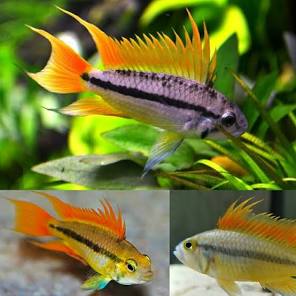Midwest Aquarium and Pond Supplier LLC
(138) Mega Orange Cacatuoides 1-2in
(138) Mega Orange Cacatuoides 1-2in
Precio habitual
$35.00 USD
Precio habitual
Precio de oferta
$35.00 USD
Los gastos de envío se calculan en la pantalla de pago.
Cantidad
No se pudo cargar la disponibilidad de retiro
Tank and water requirements
- Tank size: A minimum of a 20-gallon long aquarium is recommended for a pair or a small harem (one male with several females). A larger tank (30+ gallons) with plenty of décor is needed for a community setup.
- Substrate: A soft, fine-sand substrate is ideal, as this species enjoys sifting through the sand in search of food.
- Filtration: While these fish have a relatively low bioload, high-quality filtration and consistent water changes are crucial to keep nitrates low. They are sensitive to poor water conditions.
-
Water parameters:
- Temperature: Maintain a stable temperature between 72–84°F.
- pH: A neutral to slightly acidic pH of 6.0–7.5 is tolerated by tank-bred specimens, but stability is more important than an exact number.
- Decorations: Provide plenty of hiding spots with driftwood, caves (such as clay pots), and dense live plants to create territories and break up lines of sight. They will not uproot plants like larger cichlids.
Diet and feeding
- Carnivorous diet: A. cacatuoides are micropredators in the wild, feeding on small invertebrates.
-
Food types: Offer a varied diet of high-quality foods to ensure optimal health and color.
- Staple: High-quality carnivore pellets and flakes.
- Supplements: Include frozen or live foods, such as bloodworms, mysis shrimp, and baby brine shrimp.
- Feeding schedule: Feed small amounts two to three times per day.
Temperament and tank mates
- Temperament: Mega Orange Cacatuoides are generally peaceful community fish, but males can become territorial and aggressive toward other males or during spawning. Females will aggressively guard their eggs and fry.
-
Tank mates: Choose peaceful, non-aggressive species. Suitable companions include:
- Tetras (e.g., Ember, Neon, Rummy Nose)
- Corydoras catfish
- Rasboras
- Hatchetfish
- Incompatible companions: Avoid housing them with aggressive or larger fish that might bully them. Also, avoid smaller, delicate invertebrates like dwarf shrimp, as they may become food.
Breeding
Breeding A. cacatuoides in the aquarium is possible and rewarding.
- Spawning site: The pair will choose a cave, clay pot, or crevice in the wood as a spawning site.
- Parental care: The female will lay and guard the eggs inside the cave. She will become very territorial and protective of the fry. The male will patrol the outer territory to ward off intruders.
- Water parameters: To encourage breeding, feed a high-protein diet of live foods and maintain a slightly acidic pH and a temperature toward the higher end of their range
Share
No reviews

